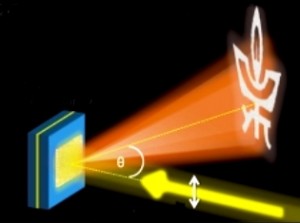All known tricks that play with our brains and make us perceive an artificial three-dimensional reality have now become completely obsolete with a new kind of “holographic technology”, developed by Tel Aviv University (TAU) researchers — doctoral students Yuval Yifat, Michal Eitan and Zeev Iluz.

Based on nanoantennas, the revolutionary holographic technology could have limitless applications in various fields.
According to the news release by Tel Aviv University, Professor Yael Hanein (of TAU’s School of Electrical Engineering and head of TAU’s Centre for Nanoscience and Nanotechnology), Professor Jacob Scheuer and Professor Amir Boag (of the School of Electrical Engineering) have led the development team whose research was published in the American Chemical Society’s publication Nano Letters.
Using the parameters of light to create dynamic and complex holographic images, the researchers managed to develop a small metallic nanoantenna chip that determines the “phase map” of a light beam with an adapted holography algorithm.
“We had this interesting idea — to play with the parameters of light, the phase of light. If we could dynamically change the relation between light waves, we could create something that projected dynamically — like holographic television, for example. The applications for this are endless. If you take light and shine it on a specially engineered nanostructure, you can project it in any direction you want and in any form that you want. This leads to interesting results,” said Yifat.
“Phase corresponds with the distance light waves have to travel from the object you are looking at to your eye. In real objects, our brains know how to interpret phase information so you get a feeling of depth, but when you look at a photograph, you often lose this information so the photographs look flat. Holograms save the phase information, which is the basis of 3-D imagery. This is truly one of the holy grails of visual technology,” said Professor Hanein.
This is a first-in-kind methodology for the successful production of high-resolution holographic imagery that can be projected in any direction.
“We can use this technology to reflect any desired object. Before, scientists were able to produce only basic shapes — circles and stripes, for example. We used, as our model, the logo of Tel Aviv University, which has a very specific design, and were able to achieve the best results seen yet,” said Professor Scheuer.
“This can be used for scientific research, security, medical, engineering and recreational purposes. Imagine a surgeon, who is forced to replot several CAT-SCAN images to generate an accurate picture. By generating just one holographic image, she could examine symptoms from every angle. Similarly, an architect could draw up a holographic blueprint that he could actually walk through and inspect. The applications are truly endless.”
The research was conducted at the facilities of Tel Aviv University Centre of Nanosciene and Nanotechnology. The work goes on, as the researchers are now trying to develop a technology that will allow the holographic images to change shape and move.




















